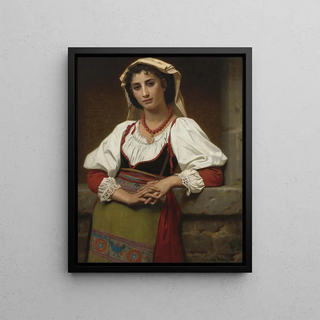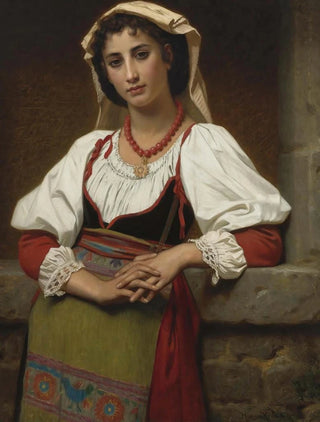Art print | The Neapolitan Girl - Hugues Merle


View from behind

Frame (optional)
In the vibrant universe of art, some works manage to capture the very essence of an era while transcending the limits of time. "The Neapolitan Girl" by Hugues Merle is a perfect example. This canvas, full of life and color, transports us to the heart of Naples, a city where culture and history intertwine passionately. The delicate composition of the piece invites us to discover a striking portrait, where feminine beauty is highlighted with palpable tenderness. Every brushstroke seems to tell a story, that of a young woman whose eloquent gaze challenges us. Light plays a crucial role in this depiction, illuminating the features of the protagonist's face and creating an intimate atmosphere that envelops the viewer.
Style and uniqueness of the work
Hugues Merle, a 19th-century painter, masterfully excels in portrait art, and "The Neapolitan Girl" is a shining example. The style of the piece is characterized by remarkable finesse in rendering textures and details. The young woman's clothing, delicately draped, seems almost tangible, while the shades of color evoke the warmth and brightness of southern Italy. Merle draws inspiration from the artistic traditions of his time while infusing them with a personal touch, thus creating a harmonious balance between realism and romanticism. The model's posture, both natural and elegant, demonstrates undeniable technical mastery, but also an artistic sensitivity that echoes human emotions. This portrait is not limited to a simple representation; it becomes a true mirror of souls, an invitation to contemplation.
The artist and his influence
Hugues Merle, born in 1823 in Paris, is an artist whose career is marked by an unceasing quest for beauty and truth. Influenced by the great masters of painting, he develops a style that is uniquely his own, combining realism and romanticism. Merle is particularly interested in the condition of women, and his works often highlight the lives of women of his time, oscillating between strength and vulnerability. His ability to capture moments of tenderness and emotion makes him a

Matte finish

View from behind

Frame (optional)
In the vibrant universe of art, some works manage to capture the very essence of an era while transcending the limits of time. "The Neapolitan Girl" by Hugues Merle is a perfect example. This canvas, full of life and color, transports us to the heart of Naples, a city where culture and history intertwine passionately. The delicate composition of the piece invites us to discover a striking portrait, where feminine beauty is highlighted with palpable tenderness. Every brushstroke seems to tell a story, that of a young woman whose eloquent gaze challenges us. Light plays a crucial role in this depiction, illuminating the features of the protagonist's face and creating an intimate atmosphere that envelops the viewer.
Style and uniqueness of the work
Hugues Merle, a 19th-century painter, masterfully excels in portrait art, and "The Neapolitan Girl" is a shining example. The style of the piece is characterized by remarkable finesse in rendering textures and details. The young woman's clothing, delicately draped, seems almost tangible, while the shades of color evoke the warmth and brightness of southern Italy. Merle draws inspiration from the artistic traditions of his time while infusing them with a personal touch, thus creating a harmonious balance between realism and romanticism. The model's posture, both natural and elegant, demonstrates undeniable technical mastery, but also an artistic sensitivity that echoes human emotions. This portrait is not limited to a simple representation; it becomes a true mirror of souls, an invitation to contemplation.
The artist and his influence
Hugues Merle, born in 1823 in Paris, is an artist whose career is marked by an unceasing quest for beauty and truth. Influenced by the great masters of painting, he develops a style that is uniquely his own, combining realism and romanticism. Merle is particularly interested in the condition of women, and his works often highlight the lives of women of his time, oscillating between strength and vulnerability. His ability to capture moments of tenderness and emotion makes him a






